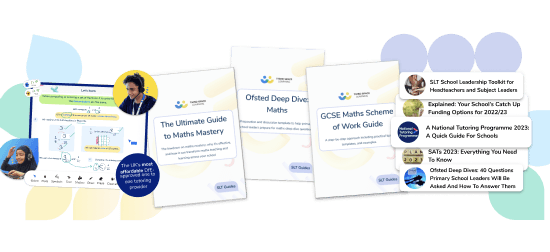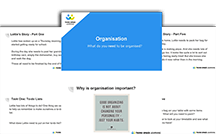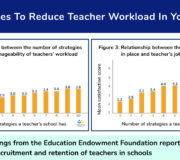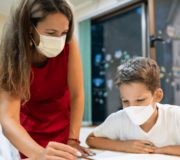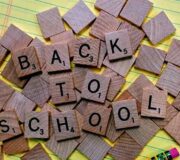Making The Transition From Primary To Secondary School During Lockdown
This blog was written during the Covid-19 pandemic and some of the recommendations may no longer be needed. We’ve got lots more practical tips and resources elsewhere for preparing year 6 pupils on their transition to secondary school.
For most of us, in Year 6, this next half term would be all about preparing children for their transition from primary to secondary school. It’s one of the busiest and also the most exciting times of year for them and for us.
SATs 2022 should be over, with residentials, performances and transition left for us to tackle before we send off our big fish to their new bigger pond.
I don’t need to tell you how different the transition process in 2020 is going to be amidst the upheaval of the Coronavirus (Covid-19) pandemic. Year 6, if they are coming back to your school, will be back in entirely different circumstances.
Smaller ‘class’ sizes, returning with less, or no, other children within the school and likely, no opportunity to visit their new school or meet the staff they’ll be working with.
With so much disruption for our Year 6 children, we need to ensure that we are offering them support in the best way possible; this is especially important as, with the ‘bubbles’, there are going to be children with a new teacher who don’t get to spend time with their normal class teacher and this may have further negative impact on top of what they’ve experienced so far.
What should the transition from primary to secondary school look like?
Year 6 is coming back in order for us to aid them with transition. But how will this look this year?
Last year, I shared a blog about Year 6 transition. We had secondary weeks, Year 7 ready lessons, and lots of activities to support a smooth transition and understanding of their new school organisation and new school life. This year we’d even planned to have a careers week.
Unfortunately, despite all the careful planning, this won’t be how it can happen! Teachers have always needed to be flexible…and now is proving that more than ever.
So, as I’ve been planning transition for my own class from primary to secondary school, I’ve also asked Twitter – primary school teachers, secondary teachers and leaders – for their ideas about what could make for a successful transition at this time.
Below, you’ll find not only ideas that you could maybe adapt for your own classes, but also some links to some resources which might be useful to you.
What to think about for the return to Year 6
Coming back for the rest of the school year, Year 6 will be split into much smaller groups. They will have to adjust to the anticlimax of SATs week not taking place, as well as the disappointment of a rite of passage being taken from them too.
Despite SATs not taking place, Third Space Learning still offers one-to-one online SATs revision lessons to make sure that students are still at the right level doing in to secondary school.
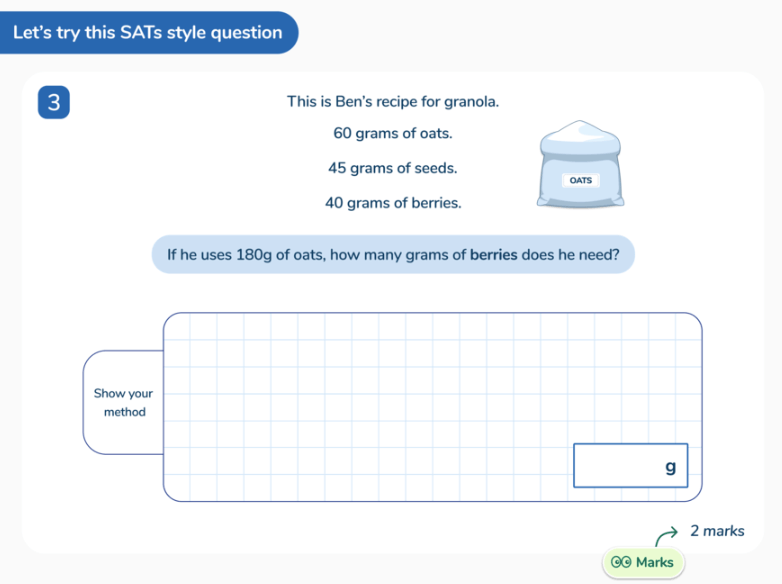
Leaving primary school is a big part of children’s lives – they have looked forward to it all year (if not longer!) and will likely feel a lack of closure without it.
Consider:
- Still preparing leavers books and hoodies which children can have before the end of the year. I know for mine, this has been something they’re still looking forward to.
- Addressing SATs and that it hasn’t happened. Yes, some children will be pleased they didn’t sit them but, there are still some children who will be disappointed that they could not show what they can do; it was what they’ve been working so hard to do all year.
- Some children will not return at all (and may be going to a different school), or there will be school staff who might have been integral to their schooling who are still self-isolating. Consider a way to allow these goodbyes to happen.
- Even the children who do return may be now taught by different teachers with whom they haven’t yet developed positive relationships.
- There are likely to be gaps in the children’s learning. Despite what is being set for them to work through at home, there are many factors which could have prevented them from successfully being completed. We need to take this into consideration with the activities they will then complete in school.
- Starting with well-being and self-esteem work. Some of these young people may not have had an easy time during lockdown and before learning can start, some time spent coming together as a group in the new school environment is important.
Wellbeing issues that may arise
Beyond returning for transition and gaining closure of their primary schooling, children will return in very different circumstances to those they left in and will need our ongoing support.
Among other things children may have:
- Experienced bereavement for the first time.
- Seen more family breakdown than may have happened if they were at school. Parents may have been furloughed, lost jobs and had money worries which are circumstantial to lockdown. Children will have been privy to more information than usual due to the close living situation.
- Children might need time to talk with a trusted adult in order to help them process their new surroundings and home-life. It’s important that this is, where possible, catered for to allow them to feel safe.
- Include wide and varied PSHE lessons to give a space for discussion and learning around our situation, as well as education on how to manage their own wellbeing in this tricky time.
Primary to secondary school transition activities
Recently, I asked Twitter for examples of activities and processes they are going to be carrying out for the transition:
Y6 / Secondary teachers: what steps are you taking next term to help the secondary transition happen?
Please RT as would love to hear from as many people as possible and get a good range of ideas of how this is happening under the current circumstances 😊
— Emily Weston 🙋🏼♀️ (@primaryteachew) May 19, 2020
Year 6 Transition Lesson: Organisational Skills
Download this free PowerPoint lesson to help your Year 6 class test their organisational skills during the Year 6 to Year 7 transition.
Download Free Now!There was a brilliant range of answers from primary and secondary school teachers and school leaders which will hopefully be helpful to you, too!
Video tours of the secondary school
Lots of secondaries are doing video tours of the buildings to help children recognise their new surroundings before they get a chance to visit the school. This will be really useful in acclimatising them when they do arrive. It would be really handy to pop a map of the school online too, which goes alongside the video.
Virtual tour of school and Q&A session with S6 pupils. Secondary staff have made a Google classroom for each cluster school for a ‘meet the teachers’ and a little taste of what they’ll do in each subject area.
— JMc (@jill_mc21) May 19, 2020
Introductions, greetings and questions videos
Consider creating a video from some of the faces around the new secondary school who could give a small greeting and piece of information about themselves.
Hopefully this will give pupils someone they can recognise when they start – it could be office staff, SLT, key teachers. It would also be lovely for children to have the chance to ask some questions, which could be answered either on a document or on video.
Some schools are having the questions answered by current Y7 pupils, which sounds a fantastic way to build positive relationships as part of the transition experience!
Getting to know you
How can we get to know the children without meeting them? One brilliant suggestion was a Google Form ‘All About Me’ which children could fill in and give important information about themselves.
What do they think the school needs to know about them before they start? I’ve found secondaries ringing me to discuss the forms we usually complete really useful in place of face-to-face meetings.
Secondary school tutors might like to send a small activity or introduction to begin to get to know the children in their form before the first day.
Creating a sense of belonging between both schools
There were suggestions around how to create a sense of belonging or ‘belongingness’. Mark (@VPMLT) is holding house events for Year children to compete in to begin feeling part of their house group, which sounds a lovely way to start getting them involved in secondary life!
We are making primary packs in themed weeks for y6. First week is about mental health and wellbeing in relation to current climate and transition and then the next week we will follow into more secondary based activities to support in the best way we without visits happening
— Kellie Griffiths (@missgriffithsy6) May 19, 2020
Primary to secondary school transition resources
There are a range of transition resources beginning to appear online. I’ve collaborated with some secondary teachers to produce some secondary style mini lessons which are across a range of subjects.
These are created to allow Year 6 students to see the type of topics and subjects they will study further, as well as allowing them to attempt some activities! It’s important that we don’t just focus on academics, though.
Children need some wellbeing and pastoral activities too which help them rebuild skills and confidence needed for the classroom. Hachette has created these transition activities which may also be helpful.
It’s a completely different water for us to navigate this year; there is no ‘good practice’ to follow but I hope that some of the above is helpful to you as you plan your Year 6 primary to secondary school transition.
Our aim after all is a fairly simple one – allow the children to build a sense of confidence and community before the transition while also giving schools an insight into their new pupils.
Read more:
The 11 Educational Principles That Will Help You Make The Most Of Your SATs Revision
A Tried And Tested Lesson Structure For Year 6 SATs Revision
DO YOU HAVE STUDENTS WHO NEED MORE SUPPORT IN MATHS?
Every week Third Space Learning’s maths specialist tutors support thousands of students across hundreds of schools with weekly one to one tuition designed to plug gaps and boost progress.
Since 2013 these personalised one to one lessons have helped over 150,000 primary and secondary students become more confident, able mathematicians.
Learn about the Year 7 programme or request a personalised quote for your school to speak to us about your school’s needs and how we can help.
